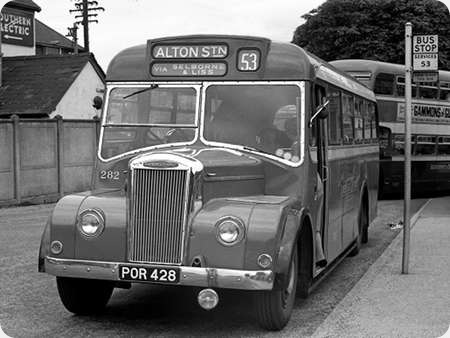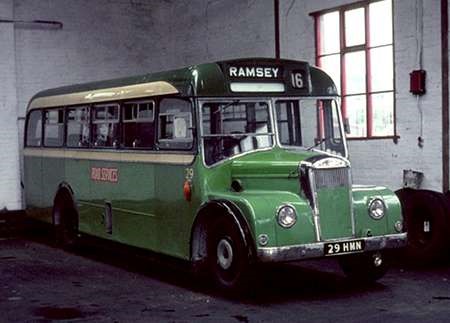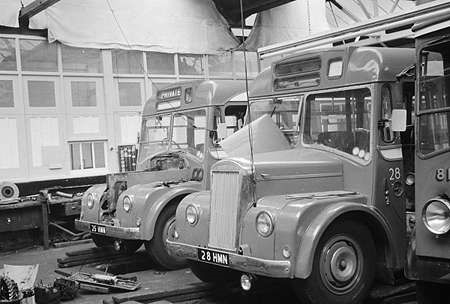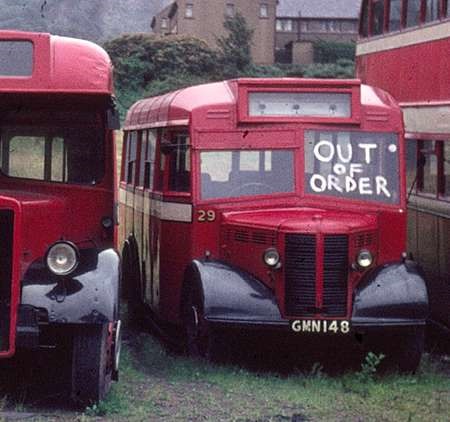Aldershot & District – Dennis Falcon P5 – POR 428 – 282
Aldershot & District Traction Co
1956
Dennis Falcon P5
Strachans B30F
In the 1930s, Dennis manufactured a bewildering choice of small buses for lightly trafficked routes – Dart, Pike, Arrow Minor, Ace and Mace. These were all replaced in 1938 by a single model, the Falcon, available in normal or forward control, with the engine options of Dennis 3.77 side valve petrol or Gardner 4LK or Perkins P6 diesel. By the onset of WW2 only around 50 had been produced. Aldershot & District took delivery of nine petrol engined Falcons with four speed gearboxes and Strachans B20F bodywork in 1939, but they saw little use before being stored for the duration of the conflict. They were placed back in service after the war but, being petrol powered, all were withdrawn by 1951. It may seem rather surprising that Aldershot & District did not consider converting these little buses to diesel power, but they had been stored in the open in the Aldershot sports field for much of the war, and the bodywork had suffered quite severely. Instead, in 1949/50, the company took delivery of fifteen new Falcons of almost identical appearance to the earlier batch, though these were of the P3 type with Gardner 4LK engines and five speed gearboxes, and the B20F bodies were built by Dennis. In 1951/2 they were reseated to B24F. Withdrawal took place between 1956 and 1960. No less than 15 more Falcons, now of the upgraded and longer P5 variety but still with 4LK engines and five speed gearboxes, arrived in 1954, and a further 8 came two years later, all with Strachans B30F bodywork. These buses marked the end of an era, as they were the last Dennis single deckers and the final Strachans bodies to be bought by Aldershot & District. The last of the batch, POR 428, fleet no. 282, was withdrawn by the Aldershot company in 1967, and, along with many of its fellows, was sold to the Isle of Man. In 1997 it was rescued and returned to the mainland, where the next thirteen years were taken up with its restoration; see-: www.adbig.co.uk/282.html
In the picture above 282 is seen in 1961 at Petersfield Station, awaiting departure on the very rural route 53 to Alton. A Dennis Loline I arriving from Guildford on route 24 pulls in behind.
Photograph and Copy contributed by Roger Cox
26/04/15 – 11:10
If I remember rightly, these buses were a ‘challenge’ to drive. The driver’s signalling window was higher than the driver’s elbow level, being closer to his shoulder level, so requiring an upward angle for his arm. I think only his hand could actually reach out, because the driver’s seat was so far inboard.
And the raked steering wheel was not positioned on the centre line of the driver’s seat either. So he was always steering through a bit of an angle – a bit like riding a horse side-saddle!
Petras409
27/04/15 – 07:47
Obviously from an era when pride in the fleet was something to be encouraged. Today’s attitude seems to be that pride is an unnecessary outdated luxury, which is an expensive time consuming drain on recourses.
Ronnie Hoye
27/04/15 – 07:48
Quite a few types of normal control buses seem to have had the steering column positioned further towards the centre of the vehicle than forward control machines. I have never driven a Falcon, but this was certainly true of the Bedford OB, the Leyland Comet and the Guy GS. In my experience of all these other examples, the bodywork tapered inwards towards the front of the vehicle allowing reasonable access to the signalling window. The Strachans body design on these Falcons retained parallel sides right up to the bonnet, and I can well appreciate the difficulty of actually extending one’s signalling arm to as mentioned by Petras 409. I agree also, that the signalling window was set absurdly high for practical use, the saloon window level being set at a higher level than that of the exactly contemporary GS, which was a delightful little bus to drive. Strachans didn’t take ergonomics into account when designing these Falcon bodies.
Roger Cox
12/02/21 – 12:20
Here is a view of 282 in its ‘new’ guise as Isle of Man Road Services 29 at Ramsey depot on 12 August 1967, so very shortly after its transfer, and still in A&D colours. There is evidence of partial repainting, as the bonnet top and dash clearly have fresh paint compared with the slightly faded wings and bonnet sides, as have the centre side panels where the new fleetname appears.
Also a view of two of its siblings in the workshops in Douglas in the course of makeover, taken on the same day. These look as if they have already received the IOMRS red livery, as even in monochrome there would be a clear difference between the two tones of A&D green.
To complete the picture there is also a view of the predecessor 29, already decommissioned, also at Ramsey – Bedford OWB/Duple UB32F of 1945.
Alan Murray-Rust
Quick links to the - Comments Page - Contact Page - Home Page
Please leave a comment
Please Note if you want to send a photograph with your comment please use the Contact Page by clicking here or send as an attachment via email.




